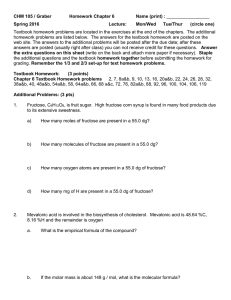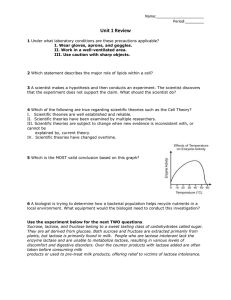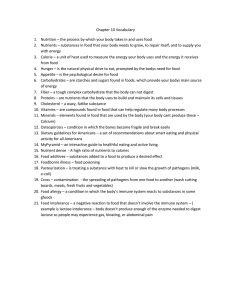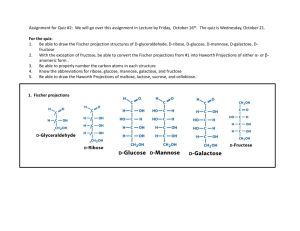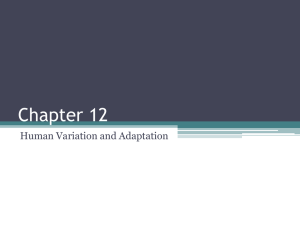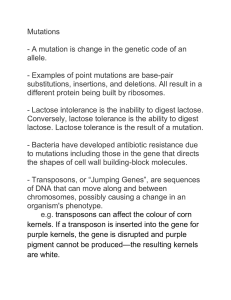Sickly Sweet: The Development of a Standardized Method Testing for and Malabsorption
advertisement
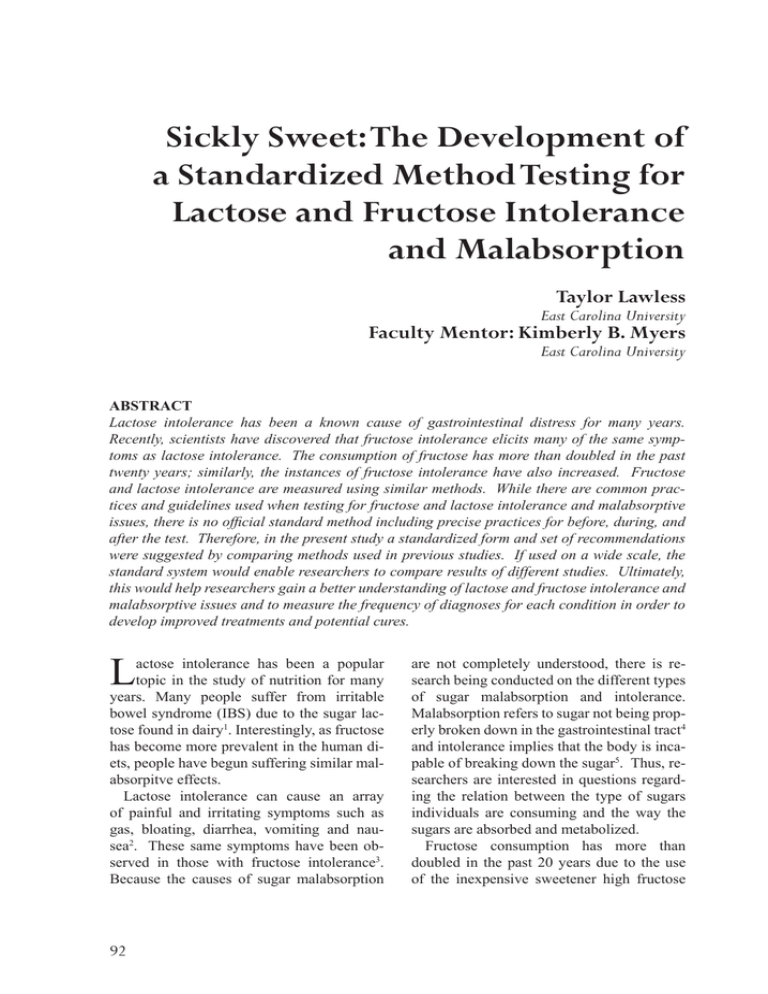
Sickly Sweet: The Development of a Standardized Method Testing for Lactose and Fructose Intolerance and Malabsorption Taylor Lawless East Carolina University Faculty Mentor: Kimberly B. Myers East Carolina University ABSTRACT Lactose intolerance has been a known cause of gastrointestinal distress for many years. Recently, scientists have discovered that fructose intolerance elicits many of the same symptoms as lactose intolerance. The consumption of fructose has more than doubled in the past twenty years; similarly, the instances of fructose intolerance have also increased. Fructose and lactose intolerance are measured using similar methods. While there are common practices and guidelines used when testing for fructose and lactose intolerance and malabsorptive issues, there is no official standard method including precise practices for before, during, and after the test. Therefore, in the present study a standardized form and set of recommendations were suggested by comparing methods used in previous studies. If used on a wide scale, the standard system would enable researchers to compare results of different studies. Ultimately, this would help researchers gain a better understanding of lactose and fructose intolerance and malabsorptive issues and to measure the frequency of diagnoses for each condition in order to develop improved treatments and potential cures. L actose intolerance has been a popular topic in the study of nutrition for many years. Many people suffer from irritable bowel syndrome (IBS) due to the sugar lactose found in dairy1. Interestingly, as fructose has become more prevalent in the human diets, people have begun suffering similar malabsorpitve effects. Lactose intolerance can cause an array of painful and irritating symptoms such as gas, bloating, diarrhea, vomiting and nausea2. These same symptoms have been observed in those with fructose intolerance3. Because the causes of sugar malabsorption 92 are not completely understood, there is research being conducted on the different types of sugar malabsorption and intolerance. Malabsorption refers to sugar not being properly broken down in the gastrointestinal tract4 and intolerance implies that the body is incapable of breaking down the sugar5. Thus, researchers are interested in questions regarding the relation between the type of sugars individuals are consuming and the way the sugars are absorbed and metabolized. Fructose consumption has more than doubled in the past 20 years due to the use of the inexpensive sweetener high fructose Taylor Lawless corn syrup3. Fructose is naturally found in fruits and some vegetables. It is also part of the simple sugar sucrose, which is a disaccharide commonly known as table sugar. Sucrose is comprised of glucose and fructose molecules, which are both monosaccharides. High fructose corn syrup contains a higher percentage of fructose than glucose. Its use is controversial as it is added to many foods as a sweetener because it is less expensive, but not necessarily healthier, than table sugar. It has been said that the increase in instances of intolerance is because it fructose is now in more foods6. While the full effect of this increase of fructose in foods is not yet known, more instances of fructose malabsorption are being diagnosed. Some attribute this malabsorption to the metabolic pathway of fructose, speculating that fructose is absorbed by facilitated diffusion or that fructose can only be absorbed with glucose5. While the absorption of fructose is still being studied, it is known that the enzyme lactase breaks lactose into the simple sugars galactose and glucose in the human body7. Fructose and lactose malabsorption and intolerance can impact the life of an individual tremendously, and misdiagnosis of these conditions can also have negative implications. If a person is incorrectly diagnosed with an intolerance, the individual may eliminate the sugar from the diet unnecessarily2,8. That is particularly concerning with lactose because restriction of lactose can lead to calcium deficiencies9. A diagnosis implying the person is not intolerant when the person is can be dangerous as well since the person will continue to consume the sugar and experience discomfort1. Hydrogen breath tests are the primary tool used to measure fructose and lactose malabsorption and intolerances. The inconsistencies associated with conducting such tests have raised questions regarding the validity of the results1. Testing differences also makes it difficult for scientists to compare results. For these reasons, we recommend a standard system of measurement to alleviate the ambiguity of varied extant testing systems. The research questions for the present study were 1) what are the common characteristics of the methods and results published in the current literature, and 2) could the common features of testing be combined to create a standard method for testing? A literature review on fructose and lactose malabsorption studies was conducted. The review was conducted after analyzing published articles about fructose and lactose malabsorption and intolerance in order to build a knowledge foundation about common practices. The primary focus of the review was on the methods used for diagnosis, and the results obtained in the treatment studies. The methods used for diagnosis often affected the conclusions about the results, thus, we reviewed methods and results together. Literature Review One of the most referenced studies was one by Choi et al. 3. The objective of this study was to determine how common fructose intolerance was in the sample population and to see if lifestyle changes regarding fructose intake would have an effect on IBS experienced by the patients. The researchers questioned how effective the fructose restricted diets would be for limiting IBS. Those with positive hydrogen breath test results were deemed fructose intolerant. The patients who produced a positive breath test were then given a kit that contained information regarding a fructose restricted diet and were asked to implement the diet. After one year, patients were asked to return and repeat the same tests and surveys. In addition, the patients answered questions regarding how strictly the diet was followed according to the guidelines and how much time was spent following the guidelines3. The results showed that of the 80 participants, 31 had a positive fructose breath test. Greater than 90% of those with a positive test claimed that the test caused the usual gastrointestinal discomfort symptoms, which have been attributed to fructose intolerance. The 93 Explorations |Natural Science and Engineering patients reported that the lifestyle changes had a mild to moderate effect on their lifestyle (a rating of 2.93 on a 5-point scale). The researcher concluded that there was a correlation between the lifestyle changes and the symptoms of those in the positive test group3. Da Silva Mederios, et al. 2 reported on a pediatric population. In the pretest procedure, the children’s height and weight were measured and parents were asked to fill out a symptom form for their children2. This is a potential source of bias as the parents cannot feel exactly what their children do. The children were given a hydrogen breath test which was used to determine whether or not they were an absorber of lactose or malabsorber. The night before, they were asked to eat white rice with chicken and not to eat after the meal2. Calcium deficiencies were examined in this study. While most of the studies on calcium absorption focus on adult populations, this study is one of the few that has examined a younger population. Other studies found that the calcium intake was much lower among the lactose intolerant; however, this study did not support that theory; there was no statistical difference in bone density between the two groups (absorbers and malabsorbers)2. The lives of individuals could be improved by the results of the studies about fructose and lactose. For example, researchers suggest that by limiting lactose in the diet, the pain suffered by afflicted children could be reduced10. Other researchers4 determined that fructose and lactose malabsorption can be the cause of recurrent abdominal pain and that removing the malabsorbed sugar from the diet of the patient can help alleviate the symptoms4. Similar results were noted by Choi,et al3 and Gomara, et al5. Further, Gomara, et al. found that fructose restriction can reduce IBS in pediatric patients5. In addition, there appears to be a relationship between age and the ability to absorb fructose and lactose; results suggested a positive correlation for fructose, but none for lactose11. 94 Review of best practices: Comparison and analysis Best practices from several reviewed studies were used to create a “standardized method and tool.” Inclusion criterion for the studies were 1) publication dates between 2008 and 2012 and 2) the use of a hydrogen breath test and the measurement of the sugars fructose, lactose or lactulose. Representative studies reviewed are included in Table 1. The six variables noted for each study were Primary Researcher; Publication; Year; Sugar Tested; Subjects; Pre-Test; During Test; and Results. “Primary researcher and publication year” were used to identify the study. The “sugar tested” variable noted whether the study examined fructose, lactose, lactulose or a combination of the three. The “subjects” variable identified the age group, gender, and general information about the participants in the study. The “pre-test” variable described the practices and procedures before the test. The “during test” variable detailed how the test was conducted. The “results” variable was used to list the findings of each study. The results of the compilation can be found in Table 1. Common trends were observed and the most effective methods were determined by the researchers. We determined the most consistent methods according to the table. Then the best practices were selected to be compiled for the creation of a standardized tool. The standardized tool can be seen in Figure 1. The standardized tool is a form with procedures that are to be followed and is to be completed by the physician or researcher. Each step of the tool was added to ensure each test produces accurate results. Additional steps were developed in order to create consistency between different test administrators. These simple preventative steps make it possible to compare test results from different medical or research sites. If the steps are properly followed and the data are accurately entered into the form, then the results across studies will be more comparable. It was common in the studies reviewed Taylor Lawless for the subjects to be asked to avoid high fat meals and foods containing fructose and lactose the day before testing (Table 1). The purpose of the request was to avoid results being skewed from hydrogen production from the breakdown of the meals of the previous day. For example, in the study of children in San Paulo2, the researchers requested that children eat white rice with ground chicken that had been fried or roasted as the last meal before the test. The simplicity of that meal made it easy for participants to comply and the meal is also low in fat and does not contain lactose2. The fact that all of the patients had the same last meal added to the interpretability of the study. Therefore, in order to increase consistency and decrease stress to the patients trying to follow the dietary guidelines on the day before the test, we suggest that prepackaged meals should be provided. Three square meals and optional snacks should be given to the patient to consume on the day before the test. The meals would be prescribed by the physician and will be low fat and lactose free. There should be a list of meal options from which the patients can select meals. Then the meals will be known to the physician and the nutrient content will be easily accessible. The patient will not be required to consume the entire meal as the meals are only to ensure that the low fat, lactose free guidelines are followed. We further suggest that compilation of fructose recipes and appendices from The Sugar Fix 6 would be a great reference to provide patients for the day before the test and for a fructose free diet. The Sugar Fix by describes the negative influence fructose has on the human body6. The recipes that contain lactose or that are high fiber should be excluded or the problematic ingredient should be substituted. We also suggest that all meals consumed should be recorded. Notes may be added regarding how much of the food was consumed, but it is not necessary. If high fat foods or foods containing lactose were consumed, the patient must come back for testing another day having followed the procedures properly. Thus, the standard form (see Figure 1) has a specific box asking if the patient has followed the dietary restrictions. We also recommend that the patients should fast from 10:00 pm until after the testing time. The studies described in Table 1 suggested different times, such as after last meal or from midnight. We recommend 10:00 pm for its convenience for varying patient schedules. The 10:00 pm fast start allows ample fasting time, while still pinpointing a standard time for patients to stop eating. We recommend that smoking and exercising are prohibited from bedtime until after the test has been completed. This was consistent in many of the studies because these activities affect the volume of hydrogen produced and excess hydrogen can skew the results3,11,14. We further note that the sex of each patient should be recorded as should the height, weight and waist circumference for comparative analysis. Fasting blood glucose and iron levels should be measured as well because the tests are easy to perform and may prove useful in later studies. Recording those measures for later analysis is not time consuming and is relatively inexpensive. Trends relating iron and glucose levels to intolerance may be observed if they are regularly recorded. As shown in several of the studies2,14, the mouths of the patient should be sanitized in order to prevent the bacteria in the mouth from affecting the results. Teeth should be thoroughly brushed and antiseptic mouthwash should be generously used. The standard form provides a safeguard to ensure that this is done. The majority of studies used solutions of fructose or lactose in water. Several studies used lactulose as a constant as it is always malabsorbed. The sugar solutions posed an issue in some studies when patients refused to drink the solution4. In order to combat that issue and to more accurately reflect the ways the sugars are found in nature, it was suggested that natural food should be used for the tests13. For example, raisins could be used to measure fructose intolerance and 95 Explorations |Natural Science and Engineering milk to measure lactose intolerance. The sugar solutions are highly concentrated and do not reflect their naturally found counterparts13. However, using natural foods would pose many issues such as making sure the same concentration of sugar was in each dose and the other component of the natural food may affect the results. Thus, we recommend that the sugar solution (fructose or lactose in water) continue to be used. Several of the studies assigned sugar intake based on body mass in kilograms2,10,11. The most common assignments were 0.5 g per kg of body weight for fructose and 2 g of lactose per kilogram of bodyweight2,10. However, we disagree with this method. We recommend that a standard amount of sugar solution is administered, as this can reflect a standard serving. Based on the review of studies, we recommend that breath hydrogen be measured every 30 minutes for three hours. An increase of 20 ppm over baseline constitutes a positive result. Finally we recommend that all data collected should be entered into the form provided (see Figure 1). This form should be completed electronically so that it can be saved by the doctor and submitted to a database. Each patient should be given an ID number so the information is confidential. If electronic, the form can be submitted to a database where all of the results across the world can be compiled. This compilation of information will allow researchers to analyze data and observe trends. Such trends can be used to better understand malabsorption and intolerance. This process could be facilitated by creating an app. The app would contain the meal choices, the test form and the procedure instructions. During the test the physician could enter the patient data directly into the app form which would be loaded on to an icloud database. By creating a database via the icloud all physicians would have access to the data, allowing them to compare results. Patient identities would remain confidential as each patient would be assigned 96 an identification number known only to the physician providing analysis. Conclusion There have been significant advances in the study of sugar malabsorption and intolerance issues. While more studies have been conducted on lactose, fructose related issues are becoming more prevalent. The increased prevalence is likely due to the increase of fructose consumption3. Removing sources of fructose such as fruits and vegetables could result in vitamin deficiencies and low fiber intake, just as several of the lactose studies suggested that calcium deficiencies could result in the avoidance of dairy9,12. A standard test and reporting system for lactose and fructose intolerance and malabsorption should be adopted. Based on our review of best practices, the test should begin with a night of fasting. A hydrogen breath test using lactulose should be conducted for continuity. The results of the test could be used as the control or baseline hydrogen values of the patient. A standard food frequency questionnaire should be distributed to gather data regarding the sources and quantities of fructose and lactose consumed. In addition, follow up hydrogen breath tests using fructose and lactose should also be conducted. By using a standard test, it would be easier to analyze and compare the results. In addition a standard diagnosis could be created. This would make it easier to determine the sugar absorption of an individual. After a standard is set, more studies on fructose and lactose could be conducted. If the causes of sugar malabsorption and intolerance are all determined, researchers could work towards a solution to avoid the negative effects produced by the malabsorption and intolerance. This tool will be helpful in consistently determining cases of fructose and lactose intolerance and malabsorption. By adopting a standard procedure, people will be able to more easily understand tests and the results of the test1. This is especially important during this time where there has been an increase in Taylor Lawless cases of fructose intolerance3. The standardized method will also be beneficial to those with lactose intolerance. In order to be successful, this system must be adopted and used on a wide scale. By having an app created for physicians and researchers to use, they could save the data to the database and access information from other patients to compare and contrast. Due to the standardized protocol, results from all studies would be possible to compare. Hopefully, this database would provide information that would lead to further studies involving the control and treatment of fructose and lactose intolerance and malabsorptive issues. The overall quality of life of those who have such issues would be improved as symptoms such as gas, bloating, diarrhea, vomiting and nausea2,3 would decrease or be alleviated altogether. By standardizing the testing procedures, scientists would be one step closer to being able to treat lactose and fructose intolerance and malabsorption. 97 Explorations |Natural Science and Engineering Figure 1 Fructose and Lactose Malabsorption and Intolerance Test Sheet 98 Table 1 Taylor Lawless 99 Explorations |Natural Science and Engineering Works Cited 1. Barrett, J. S., & Gibson, P. R. (2012, May). Fructose and lactose testing. Australian Family Physician, 40(5), 293-296. 2. da Silva Mederios, Lillian C., et al. (2012). Lactose malabsorption, calcium intake, and bone mass in children and adolescents. Journal of Pediatric Gastroenterology and Nutrition 54.2: 204-09. 3. Choi, Young K., et al. (2008). Fructose intolerance in IBS and utility fructose-restricted diet. J Clin Gastroenterol 42.3: 233-38. 4. Gijsbers, CFM., et al. (2012). Lactose and fructose malabsorption in children with recurrent abdominal pain: results of a double blind test." ACTA Pediatica: e411-15. 5. Gomara, Robert E., et al. (2008). Fructose intolerance in children presenting with abdominal pain. Journal of Pediatric Gastroenterology and Nutrition : 303-08. 6. Johnson, R. J., & Gower, T. (2008). The Sugar Fix. New York, NY: Pocket Books. 7. Koga, M., Murai, J., Saito, H., Mukai, M., & Kasayama, S. (2010, July 14). Habitual intake of dairy products influences serum 1,5-anhydroglucitol levels independently of plasma glucose. Diabetes Research and Clinical Practice, 122-125. 8. Bolin, T., et al. (2010). Malabsorption may contribute to malnutrition in the elderly. Nutrition, 26, 852-853. doi:10.1016/j.nut2009.11.016 9. Nicklas, Theresa A., et al. (2011). Self-perceived lactose intolerance results in lower intakes of calcium and dairy foods and is associated with hypertension and diabetes in adults. The American Journal of Clinical Nutrition: 191-98. 10. Ockeloen, L., & Deckers-Kocken, J. (2012). Short- and long-term effects of a lactose restricted diet and probiotics in children with chronic abdominal pain: A retro spective study. Complementary Therapies in Clinical Practice, 18, 81-84. doi:10.1016/j. ctcp.2011.11.002. 11. Jones, H. F., et al. (2011, May). Effect of age on fructose malabsorption in children presenting with gastrointestinal symptoms. JPNG, 52(5), 581-584, doi:10.1097/ MPG.0b013e3181fd1315. 12. Matlik, L., Savaiano, D., McCabe, G., VanLoan, M., Blue, C. L., & Boushey, C. J. (2007, September). Perceived milk intolerance is related to bone mineral content in 10- to 13-year-old female adolescents. Pediatrics, 120(3), e669-e677. doi:10.1542/ peds.2006-1240. 13. Bate, J. P., et al. (2010). Benefits of breath hydrogen testing after lactulose administration in analyzing carbohydrate malabsorption. European Journal of Gastroenterology & Hepatology, 22, 318-326. doi:10.1097/MEG.0b013e32832b20e8. 14. Babu, J., et al, (2010). Frequency of lactose malabsorption among healthy southern and northern Indian populations by genetic analysis and lactose hydrogen breath and toler ance tests. American Journal of Clinical Nutrition, 91, 140-146. doi:10.3945/ ajcn.2009.27946. 100
